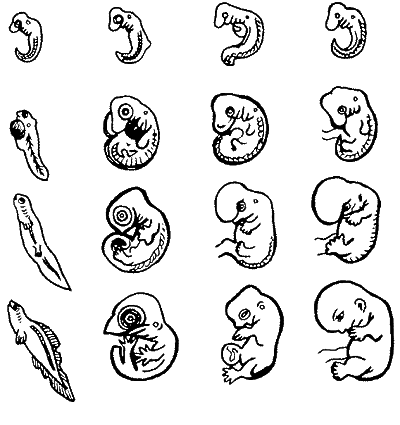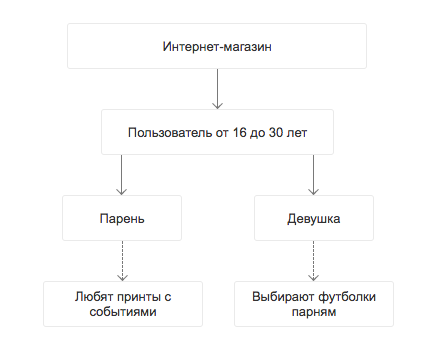User behavior patterns

The behavior of any living organisms, whether it is an infusoria or even a person, is not so difficult to predict. You do not need to be psychic. The main thing is to correctly classify the object of study. So, the topic that I would like to talk about today is patterns of user behavior and their use.
Patterns as the basis of everything
All of us, one way or another, met patterns (patterns) in real life. But some even have no idea how common they are in our lives. They can even be called divine, because, according to the Bible, Adam was created in the image and likeness of God.

Creation of Adam, Michelangelo
')
If, however, adhere to Darwin's theory, then here there are a lot of examples of their use. Recall, for example, a course in school biology, which spoke about the similarity of animal embryos in the early stages of development, when it is almost impossible to distinguish a human embryo from, say, a turtle embryo.

Comparison of embryos of various animal species
It would be logical to assume that the similarity will not be limited only to the original look, but will be applied in the future. This may concern the nervous system, the process of digestion, as well as behavior.
All these patterns are necessary for one thing - to simplify the creation process, because it is much easier to adjust the conveyor process than constantly reinventing the wheel, especially when it comes to partially similar tasks.
With proper classification, it is as easy to predict how theoretically an object can be created, as well as how it will behave in certain situations.
Patterns in Psychology
Patterns, or, more precisely, classification, probably, is the basis of all sciences. The classification helps scientists to explain the areas under study and to build theories for further study.
Psychology is no exception. You have probably heard about sociotypes and types of temperament, extroverts and introverts.

4 types of temperament
All this is an attempt to classify people. Having understood what type of person a person is, a psychologist can predict his further actions and thoughts. Based on the information received, the specialist tries to direct the patient to make a decision, or to answer the question he asks himself, but for some reason cannot answer. Ideally, the patient himself should come to the final point.
In a similar way, psychics and other paranormal supporters act. In essence, their work is practically no different from the work of a psychologist. With the exception of the element of "mysticism", which helps people find a channel for finding the answer that interests them in the depths of consciousness, when this very answer seems to give a third party. As an example, you can consider conversations with deceased loved ones. At the beginning, the psychic asks leading questions about the object, its environment, causes of death, etc. This is necessary in order to grope the very thread that will allow you to find the weak point of the client. As a result, a psychic under the guise of a translator from the language of the other world tells the client what he wants to hear to calm him down (for example, you can open any series of “Psychic battles” or another psychic show).
We will not go into mysticism and just try to apply some knowledge of psychologists to work with users.
User classification
In an era when the Internet can even meet in your fridge, a person is partially impersonal. On the Internet, no one will know that you are a cat.

However, there is still a person at the other end of the wire (until the AI systems have completed the Turing test, but then all is not lost), which has its habits, tastes, attitudes and fears. Based on them, we, like psychologists, can both predict his behavior and manipulate him. As one of the foundations of classifications of user behavior on the Internet, let us take the habitual behavior pattern we are used to - temperaments.
Adapt it to the realities of the web:
- Choleric activists. As a rule, such users want to get everything they need from your product. They do not like to waste time. Search for something, find, understand - not in their habits.
- Phlegmatic - unhurried. Before you perform any action necessarily understand. Can read agreements, all texts on pop-ups. We are ready to devote our time to studying the product, but only if it really is necessary.
- Sanguine men are hot. Such users should always be kept in good shape, because with a loss of interest, he simply "merges." Like choleric, quickly react to all incoming information. The difference is that they easily accept their own mistakes.
- Melancholic - fearful. Afraid to make a mistake. When an issue or a complex action arises, they prefer not to understand, but simply to close and forget. Such users usually do not choose payment by card directly on the site, since They are afraid, for example, to make a mistake when entering data.
Ideally, when designing a product, all these types should be considered (with some exceptions, of course). However, you should not overdo it, because, as you know, you will not please everyone at once. In the early stages of development, it is best to take the weak points of all types and eliminate the possibility of their appearance to the maximum.
Yellow Brick Road - Behavior Map
To help analysts, designers and marketers in the division of their users into groups can come a map of behaviors and classifications. With this card you need to group users according to certain characteristics (sex, age, etc.), as well as to prescribe the appropriate behavior for these groups.
For a small example, take the business of selling t-shirts with prints in an online store. Let's make an initial image of a typical buyer - a young guy or girl age from 16 to 30. So, already at the first step, we form a small classification:

So, it is already possible to work with these two classes. You can, for example, build simple logical chains of the following form:
If the user is a man (looks at men's t-shirts), then offer him men's t-shirts.Let a little, but we already have input data. Let's go further. Online store ready, T-shirts arrived at the warehouse. The opening will take place. After a while, it turns out that the female part of the audience, in addition to women's watches, also includes men's t-shirts. We assume that girls look T-shirts as a gift to their young people. The male part of the users from time to time shows interest in T-shirts of a certain subject, for example, hockey and comics. For the first case, we conclude that in the online store you need a block "As a gift for a guy", where we derive the most popular T-shirts. We tie the second case to the release of the next film from Marvel or DS, and to the beginning of the championship. Consequently, the male part of the audience buys T-shirts with prints of a mass event. Several blocks are added to the classification card of our clients.

Thus, with the development of your business, the map will expand, you will make new assumptions about how your users will behave, how to influence this or that group of customers. The more data you receive, the more you will know about your customers, the more accurately you can organize your advertising campaigns.
Instead of conclusion
The examples described in the article are just an attempt to show in which direction one can “dig” when designing their product. Do not forget that your decision may have a specific audience that can behave quite the opposite.
The best option would be to find out for yourself who would be interested in your offer, find a similar person (potential client) and just chat with him. This can serve as a starting point.
Source: https://habr.com/ru/post/337382/
All Articles